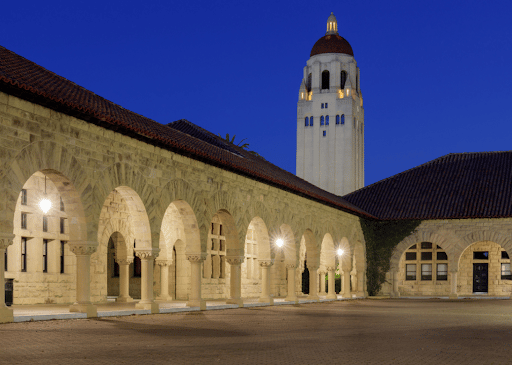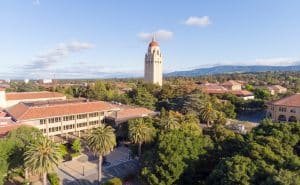When was Stanford Founded?
When was Stanford founded? Stanford University, formally known as The Leland Stanford Junior Institution, was founded in 1885. Located in Stanford, California, the private university is situated 37 miles southeast of San Francisco and 20 miles northwest of San Jose. It finds itself at the heart of Silicon Valley and directly next to Palo Alto, California.
Jane Stanford, wife of railroad tycoon and former California Governor Leland Stanford, played a crucial role in the university’s establishment. The institution was named in honor of their only son, Leland Stanford Jr., who tragically died of typhoid fever just shy of his sixteenth birthday. Both locals and university community members often refer to the school as “The Farm,” a nickname that pays tribute to its location on Leland Stanford’s former horse farm.
The founding grant for the university was laid on November 11, 1885, with the first Board of Trustees receiving it on November 14, 1885. The cornerstone was set on May 14, 1887, and Stanford officially opened its doors on October 1, 1891. At that time, there were 559 students enrolled, and tuition was free, with 15 faculty members, seven of whom were from Cornell University.
Among Stanford’s inaugural class was young Herbert Hoover, who later became the 30th President of the United States. He claimed to be the university’s very first student, based on the distinction of being the first person in the first class to sleep in the dormitory. Since the time Stanford was founded, it was originally designed to admit both male and female students, but for many years, it maintained a stringent quota on the number of women who could enroll.
During the summer of 1886, when initial plans for the campus were being formulated, Leland Stanford invited the president of the Massachusetts Institute of Technology, Francis Amasa Walker, as well as a prominent landscape architect from Boston, Frederick Law Olmsted, to come out to the west coast for consultations.
Olmsted conceived of the overall layout for the campus and its buildings, and he decided against constructing them on a hillside in favor of a more practical flatland location. Then, Charles Allerton Coolidge developed this concept in the style of his late mentor, Henry Hobson Richardson, in the Richardsonian Romanesque style, which is characterized by rectangular stone buildings linked by arcades of half-circle arches. This style is also known as the Richardsonian Gothic style.
The original campus was laid out in the Spanish colonial style known as Mission Revival, which is prevalent across the state of California. The red tile roofs and substantial sandstone masonry give the structures a look that is unmistakably Californian, and the majority of the buildings that were constructed subsequently have kept their exteriors looking the same. The juxtaposition of the bright blue skies and the red-tiled roofs that are typical of this region is one that is known for being very complimentary.
The earthquake that struck San Francisco in 1906 was responsible for the destruction of a significant portion of this original structure. The earthquake was responsible for the destruction of portions of the Main Quad, including the first iteration of the Memorial Church, as well as the gate that served as the primary point of entry to the university; however, the university was able to salvage the Quad, the old Chemistry Building, and Encina Hall (the residence of John Steinbeck and Anthony Kennedy during their times at Stanford).
After more damage was caused by the Loma Prieta earthquake in 1989, the University of California developed a capital-improvement plan with a budget of one billion dollars to retrofit and remodel older buildings so that they could be used for modern purposes.
What is Stanford Known for?
Since its founding in 1885, Stanford has been known not only for its excellent academics but also for the high return on investment it provides and the entrepreneurial spirit of its student body. Students at Stanford are valued for their technical aptitude as well as their capacity for strong leadership, making the university something of a hybrid between MIT and Harvard.
The school places a higher priority on subjects related to science, technology, engineering, and mathematics (STEM), but it also places a high value on students who have a wide range of academic interests. This is reflected in the admissions process, in which Stanford places a higher weight on the several brief essays that can be found in its supplement.
One of the things that Stanford University is most famous for is its academics. Since it was founded, admission to Stanford University consistently ranks among the most competitive in the country and has resulted in the institution’s campus being crowded with outstanding professors, smart students, and a mindset that is achievement-oriented. There are seven schools that make up Stanford:
- School of Earth, Energy & Environmental Sciences
- School of Engineering
- School of Humanities & Sciences
- Graduate School of Business
- Graduate School of Education
- School of Law
- School of Medicine
Only three of these seven schools—the School of Earth, Energy & Environmental Sciences, the School of Engineering, and the School of Humanities & Sciences—offer undergraduate degrees: Despite its reputation as a school that sends students to Silicon Valley, Stanford University offers more than 65 different majors to its students. These degrees range from Aeronautics and Astronautics to Urban Studies.
The School of Engineering at Stanford University, which holds the number two spot on the U.S. News list of the finest undergraduate engineering programs, is the most well-known of the undergraduate schools at Stanford. The academic structure of the engineering program is divided into nine departments:
- Aeronautics and Astronautics
- Bioengineering
- Chemical Engineering
- Civil and Environmental Engineering
- Computer Science
- Electrical Engineering
- Management Science and Engineering
- Materials Science and Engineering
- Mechanical Engineering
Since the time Stanford was founded in 1885, interdisciplinary research has always been given a high priority at Stanford University. The institution has established plenty of opportunities for students to work together who come from a variety of academic disciplines. The Hasso Plattner Institute of Design in the School of Engineering sometimes referred to as “the d.school,” brings together students and faculty from a wide variety of disciplines in order to facilitate the exchange of unique points of view and to advance the design process.
In a similar vein, the Stanford Woods Institute for the Environment is a hub for the university’s interdisciplinary research on the environment and sustainability. This institute brings together students and faculty members to collaborate on finding solutions to current and future environmental challenges. When we talk about sustainability, we should mention that Stanford has the goal of running entirely on clean and renewable energy by the year 2022.
The Engineering Program at Stanford does more than merely encourage collaboration on campus; it also trains its students to participate in a world that is continually becoming smaller. Students get the opportunity to learn about technology and engineering on a worldwide scale through the university’s Global Engineering Programs (GEPs), during which they also receive experience in the real world and create professional networks in an international context.
At Stanford, regardless of the field in which you choose to pursue your education, you will be exposed to an outstanding community of academics, including the following:
- 19 recipients of the Nobel Prize
- 34 individuals who went on to win the Nobel Prize have graduated from this university.
- 4 Pulitzer Prize winners
- 12 people who have been awarded the National Medal of Science
- 31 individuals were awarded the MacArthur Fellowship
- Four recipients of the National Humanities Medal
- 2 individuals who have been awarded the Presidential Medal of Freedom
Extracurricular Activities
Although Stanford’s academics receive the majority of the attention, athletics at the university have a long and illustrious history and continue to play an essential part in campus life. Stanford has been responsible for the graduation of more Olympians (2,829) than any other college in the United States, and a Stanford student has taken home a medal in every Olympic competition in which the United States has participated since 1912.
Stanford varsity teams have won 152 national championships, including 126 NCAA crowns, and for the past 44 consecutive years, a Stanford team has claimed a national championship, the longest stretch in the nation. Stanford Athletics has found distinction beyond the Olympics as well.
Off the playing field and away from the classroom, Stanford students have access to a wide variety of additional possibilities. The Ram’s Head Theatrical Group was founded in 1911 and has since grown to become the largest and oldest theatrical society at the university. Ram’s Head is a theater company with more than one hundred members that gives its players the opportunity to perform, direct, design, and write plays. More than 6,000 individuals per year make it out to see the productions put on by the organization.
Another well-known organization on campus is the Stanford Mendicants, who are easily recognizable on account of the distinctive red blazers they wear. The Mendicants were the first a cappella group ever to be formed at the institution, far back in 1963. It is not uncommon to find members of the Mendicants serenading pupils in any location within the school, from the stage to the stairwells.
Traditions
Stanford was founded with reverence for tradition. One of the longest-running traditions at Stanford is called Full Moon on the Quad, or FMOTQ for short. It began in the early 1900s when freshmen women would meet during the first full moon of the year and receive their first kiss ever from a male senior.
Today, FMOTQ is one of the most well-known events on campus. Throughout the years, the custom has progressed from exchanging a kiss to a hug to the giving and receiving of white flowers to the introduction of new persons. This experience is continuously evolving to reflect the shifting attitudes and cultural shifts that are occurring.
The Cardinals, which is the name of the school’s sports teams, refers to the color, not the bird, and the school has never settled on an official mascot. In addition, the subject of Stanford’s mascot is also the subject of a tradition that is one of a kind. Since the band did not have an official mascot, they chose a tree as their symbol instead. The student who participates in the band and wears the tree costume is responsible for redesigning it on an annual basis.
When someone raises the topic, it is nearly impossible to avoid bringing up “the Big Game.” It is clear that an event is significant when it is given a name that is so pervasive throughout society. The first time that Stanford and its archrival, UC Berkeley (Cal), played football against one another was in 1892. Since the game has been known as “The Big Game.” When an odd number of years passes, the game is played at Stanford, and when an even number of years pass, the game is played at Cal. The two colleges are fierce competitors, and this animosity permeates every element of campus life at each of them.
What Majors is Stanford Known for?
Although the School of Engineering at Stanford may be considered one of the most prestigious, the university’s other schools offer some of the most sought-after academic programs as well. Consider enrolling in some of these top programs, for example:
Economics
Economics is another popular choice for those who are good with numbers and numbers in general. The study of economics at Stanford is broken down into a number of distinct sub-disciplines, including Behavioral and Experimental, Finance, International and Development, Government Policy Analysis, Quantitative Methods, Business Strategy, and Regulation.
Human Biology
Students who are interested in pursuing a career in the life sciences shouldn’t ignore Stanford’s Human Biology major, which is another one of the university’s most popular majors. It is one of the most popular undergraduate majors at the institution, and nearly half of the students who major in Human Biology go on to get a degree in medicine.
Management Science and Engineering
The intersection of engineering, business, and public policy is at the heart of the Management Science and Engineering major, which prepares students to become leaders in this space. The aim of the department is to promote the design, management, operation, and interaction of technological, economic, and social systems through the use of education and research as its primary means of accomplishing this mission.
Symbolic Systems
Not only is Symbolic Systems one of the most well-liked majors at Stanford, but it is also one of the university’s most distinctive. Knowledge from a variety of academic disciplines, including computer science, languages, mathematics, philosophy, psychology, and statistics, is incorporated into the application.
Political Science
If students wish to get involved with subjects such as public policy, governance systems, and institutional architecture, they should think about majoring in political science at Stanford, which is a very popular major there. The department is home to some of the most well-known names in the fields of both local and international politics, who teach a diverse range of classes.
Cognitive Science
The cognitive science major is another one of Stanford’s most popular choices for students, and it’s a good option for those who are interested in the natural sciences. Students enrolled in this program have the chance to take classes like “Introduction to Perception,” “Applied Machine Learning,” and “Data Mining and Analysis.”
Mechanical Engineering
It should come as no surprise that one of the most popular academic programs at Stanford is Mechanical Engineering, given the prominence of the university’s School of Engineering. The curriculum places an emphasis on a variety of topics, including applied mechanics, biomechanical engineering, design, computer simulations, and energy science and technology.
International Relations
Another one of Stanford’s most sought-after academic programs is International Relations, which is not to say that it comes in last place. The program is an interdisciplinary major that studies the interaction of actors in international politics. These actors can be of the state or non-state variety, such as the United Nations, the World Trade Organization, the International Monetary Fund, the World Bank, Amnesty International, and other non-governmental organizations (NGOs).
How Hard is it to Get Into Stanford?
Since its founding, Stanford University has consistently ranked as one of the most selective institutions of higher education in the United States and worldwide. Because of the large number of applicants and the relatively low number of people who are accepted, it is consistently listed as the most competitive. For the undergraduate program for the class of 2022, Stanford got 47,451 applications but only accepted 2,071 of them.
There were a total of those students, and 1,706 of them decided to enroll at the institution. This indicates that the percentage of applicants accepted into the Stanford University class of 2022 was only 4.4%. These data illustrate how competitive the admissions process is at Stanford University. If you want to attend Stanford University, you will need to begin your preparations as soon as possible and put in the effort to improve your talents.
Want to learn more about how Stanford was founded? Or do you need help putting the finishing touches on your college applications? At AdmissionSight, we have over 10 years of experience guiding students through the competitive admissions process.
AdmissionSight can help you put your best foot forward when applying to college this fall. Contact us today for more information on our services.










































